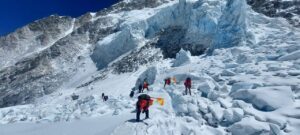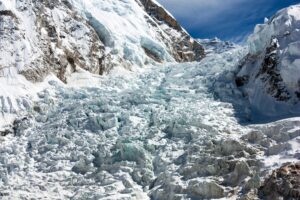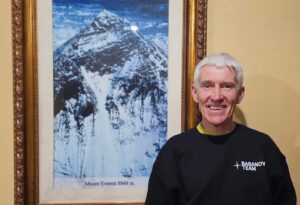“Spoiler alert! Our chances of success are very, very slim,” wrote David Gottler from a frozen base camp at the foot of Nanga Parbat’s Rupal Face.
Yet Gottler has been planning this expedition since his previous visit in the winter of 2013-14. “I think we have enough expertise, but please know that so many stars have to align perfectly for us to have a fighting chance,” he noted.

David Gottler works on Nanga Parbat’s Rupal Face Base Camp yesterday. Photo: David Gottler
No summit? So what?
Tackling the Rupal Face of Nanga Parbat in winter is remarkable enough, especially by a small team of four, using fair means. The summit is secondary. Success will be to live to tell the tale.
Same for Jost Kobusch on his nearly insane Everest climb, with all the difficulty standards set to maximum: solo, in winter, up the West Ridge. Kobusch does not even plan to reach the summit. Rather, he aims to look at the Hornbein Couloir, then maybe summit next year.
A climber rarely gets so much attention while insisting that he will not reach the top. Still, he dares to expose himself to death, yet remains convinced that he will survive to return next year, as he did last winter.

Jost Kobusch’s track up Everest’s Lho La on December 24. Graph: Reality Maps
Addicted to Everest
Kobusch is back to Lobuche after a first foray up his route, in which he ventured alone up the icefall leading to the Lho La. There, he set up a Camp 1 on the windswept col and spent Christmas Eve in absolute solitude, holding a mug of tea inscribed with the message, “I am an addict”. It was a present from his mom.

The loneliest Christmas Eve in the world? Jost Kobusch at the Lho La on Everest.
Herding cats on Manaslu
Then, there is Manaslu: On Christmas morning, Alex Txikon, Iñaki Alvarez, Oswald Pereira (and probably some more climbers) went up to Camp 1 for the night. The plan was to proceed to Camp 2 on Sunday since the ropes had been reportedly fixed. But bad weather made everyone retreat back to Base Camp. They’ll be there for the next couple of days.
The current progress of climbers on Manaslu is not so simple to track and report. Mainly, because there is not a single expedition, but nor are there separate, clearly defined teams. Instead, what we have is an uncertain number of people progressing up the normal route by expedition siege tactics. The structure is as follows:
First, a single agency — the powerful Seven Summit Treks — manages the only climbing permit on the mountain so far. Their business-oriented approach includes many types of climbers, and they are always ready to offer personalized deals.
A group of experienced Sherpas is in charge of the rope fixing. The experienced climbers on the mountain remark that all the Nepalis are friends whom they know well from previous expeditions. According to Alex Txikon, the atmosphere in Base Camp is good, and so far everyone is doing their best.

Txikon, Chhepal, Alvarez and another Nepali climber offer a brief puja before departing for Camps 1 and 2. Photo: Sendoa Elejalde
Old-time expedition climbing
Then we have a heterogeneous group of climbers of varied experience, skills, and strength. Some may rely on the help of a personal Sherpa, others carry their own gear and supplies and set their own high camps. Some are in teams, others are individuals willing to share the work on the mountain.
In this sense, this is not so different from what we saw on 8,000m peaks in a normal season 20 years ago. Everyone follows the same route and the same line of ropes at more or less the same time, but there aren’t enough Sherpas to do everything — fix ropes, set camps, carry supplies and oxygen, break trail.
In this sense, winter Manaslu is unlike the hyper-commercialized peaks in other seasons. Everybody will have to work hard if they want a summit chance. And every individual will depend in some way on the rest. As we saw in so many expeditions of the 1990s and 2000s, climbers will have to get together and agree on a common strategy. Most will accept some kind of leadership, for the common good.

Sirdar Chhepal Sherpa, in a file image from Manaslu last year. Photo: Alex Txikon
The fight for the narrative
It’s especially difficult to cover such a hybrid expedition. Each team (or individual) communicates the experience differently. Some wish to stay anonymous and just quietly climb. Others must manage professional climbing careers and sponsors, so they are very careful about what they say. Others simply speak their minds.

Gear at Camp 1 on Manaslu. Photo: Alex Txikon
Cooperation or chaos?
So what to expect, not only from Manaslu this winter but from heterogeneous expeditions in general? Two options: Either teamwork develops into fruitful dynamics, helping both progress and the information provided, or we end up with a sense of chaos, with persistent gaps and unanswered questions. This happened on last winter’s K2 expedition and this summer on Broad Peak. In both cases, the public perception of the climb suffered even as people lost their lives.
What of winter K2?
There is one more case this winter which represents the other side of the style spectrum: the still tentative commercial K2 expedition by Grace Tseng of Taiwan. Here, a single Nepali outfitter (Dolma Expeditions) fully supports a single climber.
In Tseng’s case, things are straightforward. Tseng foots the bill, plans the expedition, climbs as she prefers, and reports what she deems suitable. However, we haven’t heard news from her for a long time. Is she even going ahead at all? Time is beginning to press against her project, and with Omicron surging around the world, travel is not getting any easier.

Grace Tseng on a previous Himalayan expedition. Photo: Grace Tseng






